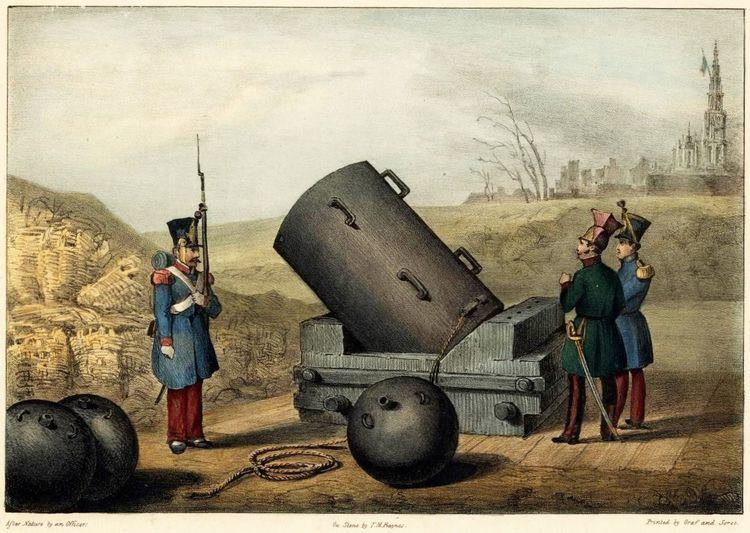Type Heavy mortar In service 1832 | Place of origin Belgium Used by Belgium | |
 | ||
Wars Siege of Antwerp (1832) | ||
The Monster Mortar (French: Mortier Monstre) is one the largest mortar ever developed. Also called Leopold or Liege mortar, the 24 inches (610 mm) caliber mortar was conceived by the French artillery officer Henri-Joseph Paixhans. The mortar was manufactured under the direction of the Belgian Minister of War Baron Louis Evain and cast at the Belgian royal foundry in Liège, Belgium in 1832. It saw action at the Battle of Antwerp in December 1832.
Contents
History
The Belgian Revolution that began in August 1830 led to the secession of the southern provinces from the United Kingdom of the Netherlands and established an independent Kingdom of Belgium. The Dutch king William I intended to suppress the Belgian Revolution in August 1831 by invading Belgium on 2 August 1831. Over the course of the next few days Belgian forces were defeated several times in battle and Dutch troops advanced deep into Belgian territory until, on 8 August, the Belgian government appealed to France for support. Following the French army's Ten Days' Campaign of the French Armée du Nord under Marshal Étienne Gérard, the Dutch troops started to withdraw. The King of the Netherlands ordered the Dutch General David Hendrik Chassé to hold, with 4500 men, the Citadel of Antwerp at all costs. From the citadel, Chassé bombarded the city of Antwerp, setting fire to hundreds of homes and causing many casualties among the civilian population. These events led to the second intervention by the French Armée du Nord of Marshal Gérard. On 15 November 1832, the French Armée du Nord and its siege specialist François Haxo began to lay the Dutch troops under siege, quickly occupying the Fort Montebello situated to the east of the citadel and to the south of the city from which they started firing at the citadel.
Description
The Monster Mortar was ordered by the Belgian Minister of War Baron Empain. Conceived by the French artillery officer Henri-Joseph Paixhans, the 24 inches (610 mm) caliber mortar was cast at the Belgian royal foundry of Cannons in 1832 in Liège, Belgium.
Next to the Monster Mortar, the largest mortars ever developed were two 36 inches (914 mm) caliber mortar: the Mallet's Mortar, designed by Robert Mallet and tested by the Woolwich Arsenal, London, in 1857, and the "Little David" developed in the United States for use in World War II). These mortars never showed action.
The "Monster Mortar" saw action on 21 December and 22 December 1832 but was abandoned in Fort Montebello soon after.
The mortar used during the Siege of Antwerp exploded during a test campaign on 18 May 1833 in Brasschaat, near to Antwerp. A second monster mortar was manufactured in Liège in 1834
